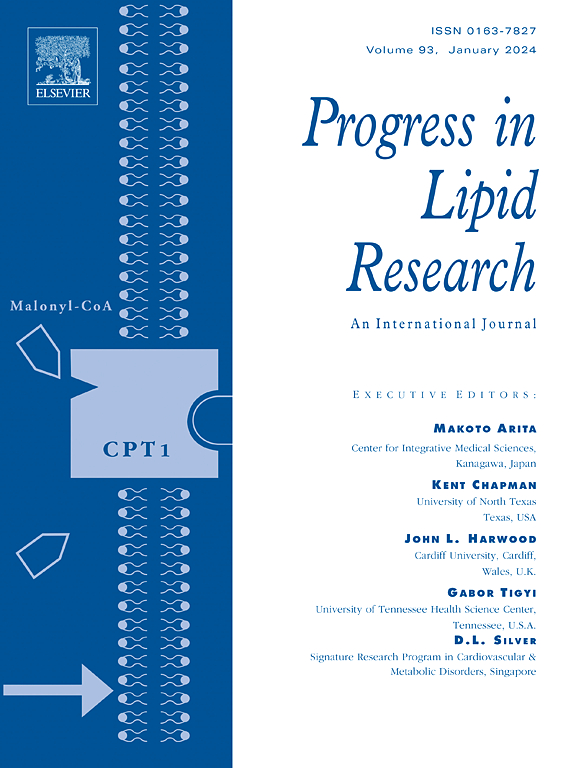Unraveling brain palmitic acid: Origin, levels and metabolic fate
IF 14
1区 医学
Q1 BIOCHEMISTRY & MOLECULAR BIOLOGY
引用次数: 0
Abstract
In the human brain, palmitic acid (16:0; PAM) comprises nearly half of total brain saturates and has been identified as the third most abundant fatty acid overall. Brain PAM supports the structure of membrane phospholipids, provides energy, and regulates protein stability. Sources underlying the origin of brain PAM are both diet and endogenous synthesis via de novo lipogenesis (DNL), primarily from glucose. However, studies investigating the origin of brain PAM are limited to tracer studies utilizing labelled (14C/11C/3H/2H) PAM, and results vary based on the model and tracer used. Nevertheless, there is evidence PAM is synthesized locally in the brain, in addition to obtained directly from the diet. Herein, we provide an overview of brain PAM origin, entry to the brain, metabolic fate, and factors influencing brain PAM kinetics and levels, the latter in the context of age, as well as neurological diseases and psychiatric disorders. Additionally, we briefly summarize the role of PAM in signaling at the level of the brain. We add to the literature a rudimentary summary on brain PAM metabolism.
揭开脑棕榈酸的神秘面纱:起源、含量和代谢命运
在人脑中,棕榈酸(16:0;PAM)占脑饱和脂肪酸总量的近一半,已被确定为含量第三高的脂肪酸。脑磷脂支持膜磷脂的结构,提供能量,并调节蛋白质的稳定性。脑 PAM 的基本来源是饮食和通过新生脂肪生成(DNL)(主要来自葡萄糖)进行的内源性合成。然而,调查脑 PAM 来源的研究仅限于利用标记(14C/11C/3H/2H)PAM 的示踪研究,而且结果因所用模型和示踪剂而异。不过,有证据表明,PAM 除了直接从饮食中获取外,还在大脑局部合成。在此,我们将概述脑内 PAM 的来源、进入大脑的途径、代谢命运以及影响脑内 PAM 动力学和水平的因素,后者与年龄、神经系统疾病和精神疾病有关。此外,我们还简要总结了 PAM 在大脑信号水平上的作用。我们还在文献中对大脑 PAM 代谢进行了初步总结。
本文章由计算机程序翻译,如有差异,请以英文原文为准。
求助全文
约1分钟内获得全文
求助全文
来源期刊

Progress in lipid research
生物-生化与分子生物学
CiteScore
24.50
自引率
2.20%
发文量
37
审稿时长
14.6 weeks
期刊介绍:
The significance of lipids as a fundamental category of biological compounds has been widely acknowledged. The utilization of our understanding in the fields of biochemistry, chemistry, and physiology of lipids has continued to grow in biotechnology, the fats and oils industry, and medicine. Moreover, new aspects such as lipid biophysics, particularly related to membranes and lipoproteins, as well as basic research and applications of liposomes, have emerged. To keep up with these advancements, there is a need for a journal that can evaluate recent progress in specific areas and provide a historical perspective on current research. Progress in Lipid Research serves this purpose.
 求助内容:
求助内容: 应助结果提醒方式:
应助结果提醒方式:


